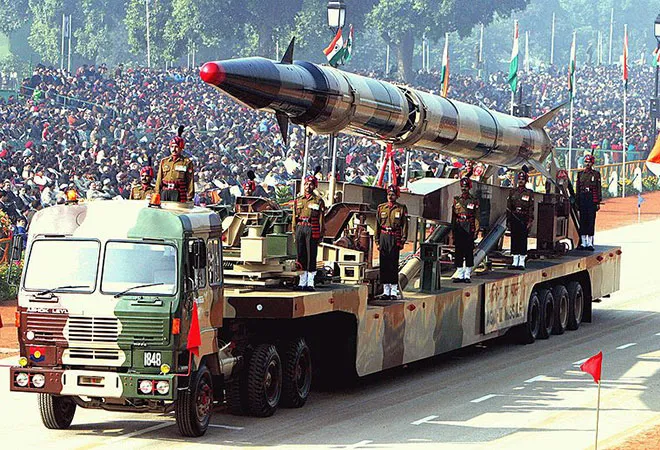Questions on credibility of massive retaliation in India's nuclear doctrine have persisted since its public revelation in 2003. Persistence of these questions was evident in the recent round of debates on review of India’s nuclear doctrine, sparked by Defence Minister, Manohar Parrikar’s
remarks on the doctrine. Assessment of massive retaliation’s credibility as a strategy of deterrence for India from the perspective of capability, cost and intention explain why the aforementioned questions persist and why massive retaliation fails to be a credible tool of nuclear deterrence for India.
Definition
What is massive retaliation for India? India’s publicly released nuclear doctrine of 2003
poses a threat of massive retaliation on an adversary if a nuclear weapon, irrespective of the yield, is used by the latter, even on Indian soldiers in the adversary’s territory. Historically, in the nuclear context, massive retaliation has been interpreted as a strategy which conveys to an adversary that the pursuit of a given objective will lead to costs that are “massive” and much more than any possible gains the adversary could acquire. What has differentiated “massive” from “proportionate” or “flexible” retaliation is that the former definitely suggests the threat of the use of nuclear weapons on large population and industrial centres. This was evident from John F. Dulles’
address of 1954 when he, as the US Secretary of State introduced this concept.
None of the Indian governments have so far detailed what would constitute its threat of massive retaliation and inclusion of “unacceptable damage” in the doctrine arguably leaves sufficient ambiguity. Nonetheless, the fact that “massive retaliation” was introduced in 2003 to replace “punitive retaliation” from the 1999 formulation of the
draft doctrine indicates that the Indian government reduced the flexibility it earlier had in its threat of retaliation. Furthermore, that New Delhi does not consider the prospects of limited nuclear exchange or controlled escalation of a nuclear conflict and, consequently, skips other choices along the nuclear escalatory ladder has been established several times, including in a 2013
speech by Shyam Saran with a degree of official sanctity as head of India’s National Security Advisory Board. This leads to the conclusion that New Delhi’s interpretation of massive retaliation is congruent to that of the United States in the 1950s.
Read | < style="color: #960f0f">
Nuclear Security in India
Credibility
How to establish and assess credibility of massive retaliation? William W. Kaufmann, while assessing the credibility of the US strategy of massive retaliation in the 1950s,
identifies “a very real risk” with this strategy of deterrence. The risk, Kaufmann explains, is that the antagonist will challenge the protagonist to make good on the threat of massive retaliation. If the protagonist does so, it will have to accept the consequences of executing the threatened action. If it does not, it will stand to lose prestige and decrease its capacity to effectively institute policies of deterrence in future. Though explained in the context of the US in the 1950s, this risk of an adversary challenging to follow up on the threat of massive retaliation remains real for India at present.
To minimise this risk, Kaufmann recommends surrounding the threat of massive retaliation with “an air of credibility” in three areas – capability, cost and intention. Substantiating it further, he notes –“the enemy must be persuaded that we have the capability to act; that, in acting, we could inflict costs greater than the advantages to be won from attaining the objective; and that we really would act as specified in the stated contingency.” While Kaufmann identifies these areas to establish credibility, he simultaneously uses them to assess if the US had or could have succeeded in making massive retaliation a credible strategy of deterrence. This provides a useful framework in assessing credibility of India’s massive retaliation as well.
Capability
A prerequisite for imposing a threat of massive retaliation is possession of thermonuclear weapons. India conducted its sole thermonuclear test under Pokharan II on May 13, 1998. The Indian government then
claimed the test to be successful and argued that the yield of 50 kiloton (KT) of trinitrotulene (TNT) was as expected. Doubts, however, emerged on this claim soon after the test. Some international
studies based on available seismic data argued that the yield was only of about 25 KT and concluded that India’s sole thermonuclear test had failed. Doubts increased further in 2009 when K. Santhanam, who was director for the 1998 test preparations from India’s Defence Research Development Organisation (DRDO), publicly
claimed that DRDO’s estimate of the yield was 25+2 KT and that indeed India’s sole thermonuclear test had failed. Indian government, nonetheless, continues to
claim that the test of May 1998 was successful and thus rejects any call for resumption of thermonuclear tests.
Politics over sanctity of India’s unilateral moratorium on nuclear test, its position on the Comprehensive Test Ban Treaty (CTBT), its membership application to the Nuclear Suppliers Group (NSG), and its integration with the global non-proliferation architecture infuse motivations to both the claims of the 1998 test being a failure and otherwise. Nonetheless, the lack of any evidence of India having weaponized thermonuclear device since 1998, coupled with doubts on success of India’s thermonuclear test, leads to the conclusion that India has failed to establish sufficient credibility in the area of capability for massive retaliation. As Kaufmann too notes, for credibility to be established, capability cannot just be potential, it must be operational.
Read | < style="color: #960f0f">Could India’s bold nuclear war plan survive a clash with Pakistan?
Cost
Cost is what the antagonist (Pakistan in this case) must bear in challenging the protagonist (India) to make good on the threat (of massive retaliation). Kaufmann argues that the cost should be greater than the possible gains the antagonist could acquire in making that challenge. In the American context, however, Kaufmann identified another issue. The adversary, the USSR, had acquired thermonuclear weapons and the capability to deliver them on the US territories by 1956 and thus the United States faced the problem of incurring the same costs which it was threatening to inflict on the USSR. Thus, for credibility to be established in the area of cost, the projected cost should not only exceed possible gains of the antagonist, but also exceed the costs that the antagonist could impose in return.
With no accurate knowledge of the numbers and sizes of operational nuclear weapons of India and Pakistan, calculation of these costs can be based on estimation of their respective stockpiles of fissile material. As Elizabeth Whitfield, while tackling the “Fuzzy math on Indian nuclear weapons” for the Bulletin,
notes – “fissile material estimation, particularly when based on open-source information, is an inexact science.” Nonetheless, most internationally agreeable
estimates suggest that the sizes of Indian and Pakistani nuclear arsenal are similar, with Pakistan possessing slightly more number of nuclear weapons. Considering these estimates, India might not be in a position to threaten Pakistan’s cost, under massive retaliation using its nuclear weapons, which will be higher than the cost which Pakistan could levy on India in return.
Intention
Perhaps the most difficult and delicate task is making intentions credible and India does not fare well on this front as well. Kaufmann argues that an intelligent antagonist would rely on three sources to gauge the protagonist’s intentions of following up on its threat of massive retaliation: statements by government officials, past record in comparable circumstances and public opinion.
In statements, the Indian government officials have been fairly consistent as far as the interpretation of the strategy of massive retaliation is concerned. While not much detail has been offered by the Indian government to the public, few statements by officials like Shyam Saran, given as the head of the National Security Advisory Board but in personal capacity, have defended the strategy and have been consistent with the Indian government’s official position. This is unlike the situation in the US during the Eisenhower administration in the 1950s, when John F Dulles’s formulation of massive retaliation was interpreted
differently by other officials of the government, including President Dwight D. Eisenhower and Vice President Richard Nixon.
This consistency in statements however is overshadowed by India’s past record and its (in)famous strategic culture of restraint. No retaliation to the Parliament attack in 2001 and Mumbai attack in 2008 – perpetrators of which allegedly had roots in Pakistan – while could have been in the larger interest of South Asia and its people, diminishes India’s ability to make its intentions of massive retaliation credible. The current Indian government’s decision to
conduct surgical strikes inside Pakistan’s territory in response to the Uri terror attack is certainly a departure from that culture. However, it is still not big enough an action to neutralize the effects India’s strategic culture of restraint has had on its image and to suggest that India would massively retaliate to even tactical use of nuclear weapons by Pakistan.
That Indian government has so far not succeeded in making its intentions of following up on the threat of massive retaliation credible is evident from the existing opinion within the strategic community in India. While domestic
critics have continued to highlight the failures of massive retaliation as a strategy of deterrence, those supporting it, like Gurmeet Kanwal, too sometimes
highlight the lack of a suitable alternative as the reason for their support.
Conclusion
Kaufmann’s framework of capability, cost and intention provides a useful tool to assess the credibility of India’s massive retaliation as a strategy of nuclear deterrence. On all three fronts, conditions do not exist for India to make massive retaliation a credible deterrent. Can these conditions be altered? Considering its plans of engaging in global nuclear commerce to meet its energy requirements, India cannot possibly conceive any decision to conduct a thermonuclear test as being in its interest. Nor can it substantially alter the balance of nuclear threat with Pakistan to address the lack of credibility in the area of cost. On intention, the government could take actions in the coming years that dilute the strategic culture of restraint, but whether that would be enough to make the intentions credible cannot be concluded. With the lack of conditions suitable for massive retaliation to be a credible deterrent at present and in the near future, the only viable choice for New Delhi will be to move towards a threat of assured, unacceptable, but flexible retaliation. Operational details of what would constitute a flexible retaliation are not required for the publicly-declared doctrine. Even with a lack of such details, what flexible retaliation would offer New Delhi is freedom from its commitment to massively retaliate against any scale of use of nuclear weapons by an adversary – a threat that is both operationally unviable and as a deterrent incredible.
This commentary was published in Science, Technology and Security forum.
The views expressed above belong to the author(s). ORF research and analyses now available on Telegram! Click here to access our curated content — blogs, longforms and interviews.




 PREV
PREV


